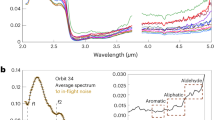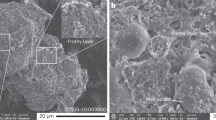Abstract
Knowledge of the textural characteristics of planetary surfaces is one of the objectives of remote sensing observations. The comparison of accurate photometric measurements with scattering models yields estimates of the compaction state of the optically active portion of the regoliths of airless bodies. We have analysed as a function of solar phase angle the observations of the Galilean satellites of Jupiter obtained with the International Ultraviolet Explorer1,2. By fitting the measurements to a shadowing model3, comparative descriptions of the microtextures of the optically active portion of the surfaces of the satellites are derived. Important differences among the satellites, and between leading and trailing hemispheres of individual satellites, result from the different processes of meteoritic bombardment, magnetospheric interaction and geological resurfacing that operate in the Jovian system. lo and Callisto have the most tenuous upper regoliths, whereas the surface of the leading side of Europa is the most compact.
This is a preview of subscription content, access via your institution
Access options
Subscribe to this journal
Receive 51 print issues and online access
$199.00 per year
only $3.90 per issue
Buy this article
- Purchase on Springer Link
- Instant access to full article PDF
Prices may be subject to local taxes which are calculated during checkout
Similar content being viewed by others
References
Nelson, R. M. et al. Bull. Am. astr. Soc. 16, 684–685 (1984).
Nelson, R. M. et al. Icarus 72, 358–380 (1987).
Irvine, W. M. J. geophys. Res. 71, 2931–2937 (1966).
Hapke, B. J. Geophys. Res. 86, 3039–3054 (1981).
Hapke, B. Icarus 59, 41–59 (1984).
Hapke, B. Icarus 67, 264–280 (1986).
Goguen, J. D. thesis, Cornell Univ. (1981).
Lumme, K. & Bowell, E. Astr. J. 86, 1694–1704 (1981).
Veverka, J., Goguen, J., Young, S. & Elliot, J. Icarus 34, 406–414 (1978).
Buratti, B. Icarus 59, 392–405 (1984).
Buratti, B. Icarus 61, 208–217 (1985).
Veverka, J. in Planetary Satellites (ed. Burns, J.) 171–209 (University of Arizona Press, Tucson, 1977).
Morrison, D. & Morrison, N. in Planetary Satellites (ed. Burns, J.) 363–378 (University of Arizona Press, Tucson, 1977).
Kawata, Y. & Irvine, W. in Exploration of the Planetary System IAU Symp. 65 (eds Woszczyk, A. & Iwaniszewska, C.) 441–464 (Reidel, Dordrecht, 1974).
Simonelli, D. & Veverka, J. Icarus 68, 503–521 (1986).
Pang, K. D., Lumme, D. & Bowell, E. Proc. lunar planet. Sci. Cont. 12B, 1543–1553 (1981).
Hansen, O. L. Icarus 18, 237–246 (1973).
Matson, D. L. & Nash, D. B. J. geophys. Res. 88, 4771–4783 (1983).
Millis, R. T. & Thompson, D. T. Icarus 36, 408–419 (1975).
Buratti, B. & Veverka, J. Icarus 55, 93–110 (1983).
Clark, R. N., Fanale, F. P. & Zent, A. Icarus 56, 233–245 (1983).
Clark, R. N. & Lucey, P. B. J geophys. Res. 89, 6341–6348 (1984).
Shoemaker, E. M. & Wolfe, R. F. in Satellites of Jupiter (ed. Morrison, D.) 277–339 (University of Arizona Press, Tucson, 1982).
Morrison, D. & Burns, J. A. in Jupiter (ed. Gehrels, T.) 991–1034 (University of Arizona Press, Tucson, 1976).
Lane, A. L., Nelson, R. M. & Matson, D. L. Nature 292, 38–39 (1981).
Johnson, T. V. et al. J. geophys. Res. 88, 5789–5805 (1983).
Lucchitta, B. K. & Soderblom, L. A. in Satellites of Jupiter (ed. Morrison, D.) 521–555 (University of Arizona Press, Tucson, 1982).
Nelson, M. L. et al. Icarus 65, 129–151 (1986).
Shoemaker, E. M., Lucchitta, B. K., Plescia, J. B., Squyres, S. W. & Wilhelms, D. E. in Satellites of Jupiter (ed. Morrison, D.) 435–520 (University of Arizona Press, Tucson, 1982).
Author information
Authors and Affiliations
Rights and permissions
About this article
Cite this article
Buratti, B., Nelson, R. & Lane, A. Surficial textures of the Galilean satellites. Nature 333, 148–151 (1988). https://doi.org/10.1038/333148a0
Received:
Accepted:
Issue Date:
DOI: https://doi.org/10.1038/333148a0
Comments
By submitting a comment you agree to abide by our Terms and Community Guidelines. If you find something abusive or that does not comply with our terms or guidelines please flag it as inappropriate.



